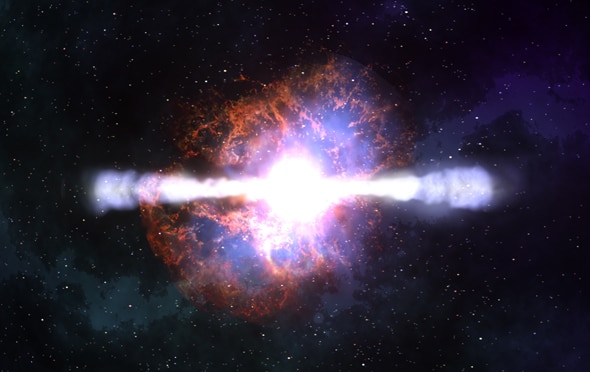Create a free profile to get unlimited access to exclusive videos, sweepstakes, and more!
How Turbulence Fuels the Most Violent Explosions in the Universe

In the final seconds of a massive star’s life, a lot happens all at once. But the outcome is inevitable: BOOM.
Just how big a boom depends on the details of everything going on. The core of a star is where the action is; that’s where lighter elements are fused into heavier ones, creating energy that holds the star up against its own powerful gravity. Eventually, though, iron is created in the core, and iron absorbs energy. Once enough is made, the star is doomed.
Without the release of energy to support it, the core collapses. It happens incredibly rapidly, falling at a large fraction of the speed of light. Stars spin, though, and as the core collapses that spin increases monumentally, just like an ice skater’s spin increases when they bring their arms in to their bodies. Not only that, the core has a magnetic field too, and that also magnifies in strength hugely as the core collapses.
What happens next is that … well, the star explodes. We know in general why that happens, but some of the details have been hard to pin down. And in some stars, the star doesn’t just explode: Instead of a normal supernova explosion (which, c’mon, is a ridiculously mind-crushingly catastrophic event) you get a hypernova, an extra-big explosion.
In a hypernova, the collapsing core generates a pair of beams, twin death rays that blast outward from the spin poles of the core. The amount of energy in them is beyond anything our puny minds can adequately grasp; in a few seconds they can blast out as much energy as the Sun does over its entire 12 billion year lifetime.
The problem is, no one knows just how these beams get made. The physics is fiercely complicated, and it’s hard to model just how the increasing spin and strengthening magnetic field of the collapsing core generate them.
At least, until now. A new study shows that the key to the beams being made is turbulence. This has long thought to be behind the beams’ creation, but this new work shows how it’s possible.
In a nutshell, the core of the star is layered, and rotating at different speeds. At the boundaries of these layers the different speeds of the gases create turbulence, swirls and eddies of gas. Some of these dissipate, just like sometimes a spinning cloud on Earth doesn’t quite get the kick it needs to becomes a tornado.
But if conditions are right, some of those swirls get amplified as the core collapses and the magnetic fields guide them. As the swirls get stronger, their embedded magnetic fields get stronger too, which amplifies the swirls more … this is a positive feedback loop called a dynamo. We use a similar technique to generate electricity here on Earth! The energy of the motion of the rotating gas is what feeds the dynamo.
In a flash, these swirls become highly organized, forming a tightly collimated spinning mass aligned with the core’s rotational axis. As the core collapses, the vortices focus up and away from the poles of the rotating mass, and the vast energies of the event find a conduit along which they can travel. When they do … well, like I said before. BOOM.
Most of the energy of the newly born supernova flows along these beams, eating their way out of the star, creating the hypernova, and generating what we call a gamma-ray burst, the most violent explosion known in the Universe today.
There are two things about these new results that really burrow into my brain. One is how it’s been known for some time that turbulence must be responsible for the beams being created; without it the models are never able to generate the beams. But getting it right is incredibly difficult due to the complexity of the calculations. So for years it’s been a matter of knowing what the answer must be, but not being able to prove it.
The other bit is the length of tine it takes for the collapsing gas in the center of the star to go from a chaotic, turbulent mess to a highly organized death-ray maker. In the video above, note the clock ticking: It’s measuring time in milliseconds, and the whole thing takes less than a hundredth of a second to form. Mind you, we’re talking about events spanning a region a dozens of kilometers across, deep in the heart of a star where the densities are billions of times higher than lead and temperatures are measured in the billions of degrees!
Massive stars are many things, but subtle they are not. They are so violent, so bright that they can be seen for billions of light-years, more than halfway across the observable Universe.
And now, finally, we are starting to really understand how they work. We may be stuck on this planet, but our imagination and scientific tools allow us to wander the stars, even plunge deep within them, and know how they work. That to me is incredibly uplifting … even more so in these turbulent times.


























